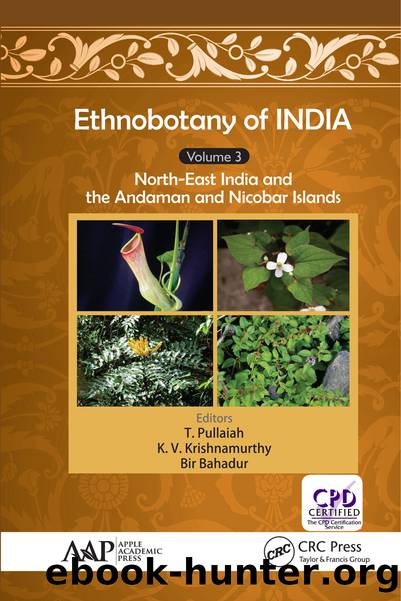Ethnobotany of India, Volume 3 by Pullaiah T. Krishnamurthy K. V. Bahadur Bir

Author:Pullaiah, T.,Krishnamurthy, K. V.,Bahadur, Bir
Language: eng
Format: epub
Publisher: CRC Press LLC
Published: 2016-08-15T00:00:00+00:00
FIGURE 8.1 Map of the Andamans.
The Andaman Islands is home to indigenous tribes who are divided by two categories: the indigenous tribal people and the outsiders. Latter who are settled in the territory due to the fact of colonial rule, include Bengali, Tamil, Malayali, Telugu, Oriya, North Indian and others (Majumdar, 1975). The blend of these two classes of people constitutes a colorful ethnicity to the people’s profile of Andamans. The indigenous tribes are generally dark in color, short in stature with peppercorn hairs belonging to Negrito stock and represented by the Great Andamanese, the Onges, the Jarawas and the Sentinelese (Sharief, 2007). The aboriginal population of the Andaman Islands, along with the Semangs of Malaysia, the Aetas of the Philippines, and the few population groups of Papua New Guinea who morphologically resemble the African pygmies, are the remnants of the ‘Negrito’ populations of Southeast Asia (Kashyap et al., 2003). Formerly, the Onge tribe was semi-nomadic, roaming around the shores of the island in response to different seasons (Bhargava, 1983).
The aboriginal tribes of Andaman are known for their skills in arts and crafts. They excel in crafts related to shells, wood, cane and bamboo. Apart from this, mat making and basketry form an integral part of their culture. There is no specific attire which is used by the people of the Andamans and they still move around naked living in the inaccessible coastal areas. A slight refinement comes with the Jarawas where they use only adornments of bark and shell, like necklaces, armbands, waist bands, etc. But, however, all the ceremonial occasions are adorned by necklaces made of shell, waistbands and headbands of bark fiber. Thus, they still preserve their tradition and culture along with their language and religion. The main occupation of the people of these islands includes agriculture, forestry and fishing. Agricultural crops consist of rice, coconuts, betel (areca nuts), fruits and spices (turmeric), rubber, oil palms and cashews. During the khariff season, paddy becomes the prime field crop. Fishery is also another major occupation of the area and not meant for domestic use. Aboriginal tribes living in coastal forests mostly make best use of their surrounding forest produce for their daily needs, for example, fuel, fodder, edibles and others items but also come out of the forest towards sea coasts and utilize its resources too, to meet their basic requirements. Among other tangible culture of the Andaman, food system of the aboriginal tribes adds to the ethnic and cultural heritage of the region. Over the years, the interactions of native food systems and that of the migrants favored amalgamation and evolution of diverse food cultures which helped in identification of more new local food resources in this small archipelago (Singh et al., 2013). Dagar and Dagar (1999) gave a detailed account of plants and animals used by the Negrito and Mongoloid tribals of Andaman and Nicobar Islands in their routine life for food, shelter, dugout canoe making, taboos, rituals and medicines (Figure 8.1).
Download
This site does not store any files on its server. We only index and link to content provided by other sites. Please contact the content providers to delete copyright contents if any and email us, we'll remove relevant links or contents immediately.
| Africa | Americas |
| Arctic & Antarctica | Asia |
| Australia & Oceania | Europe |
| Middle East | Russia |
| United States | World |
| Ancient Civilizations | Military |
| Historical Study & Educational Resources |
The Story of China by Michael Wood(927)
Mr. Selden's Map of China by Timothy Brook(774)
Philippines--Culture Smart! by Culture Smart!(669)
Heroic Hindu Resistance To Muslim Invaders (636 AD to 1206 AD) by Sita Ram Goel(655)
Akbar: The Great Mughal by Ira Mukhoty(650)
The Meaning of India by Raja Rao(631)
Vedic Physics: Scientific Origin of Hinduism by Raja Ram Mohan Roy(624)
Food of India by unknow(616)
Banaras by Diana L. Eck(613)
India--Culture Smart! by Becky Stephen(602)
China Unbound by Joanna Chiu(601)
First Platoon by Annie Jacobsen(599)
Mao's Great Famine: The History of China's Most Devastating Catastrophe, 1958-1962 by Frank Dikötter(594)
North of South by Shiva Naipaul(588)
Insurgency and Counterinsurgency by Jeremy Black(564)
How to Be a Modern Samurai by Antony Cummins(562)
A History of Japan by R.H.P. Mason & J.G. Caiger(561)
The Genius of China: 3,000 Years of Science, Discovery, and Invention by Robert Temple(560)
The Digital Silk Road by Jonathan E. Hillman(549)
